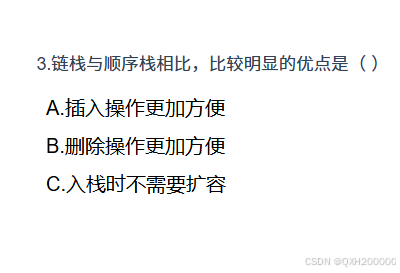【C++】—— list 模拟实现
- 1 list 基础结构
- 2 默认构造
- 3 迭代器
- 3.1 整体框架
- 3.2 成员函数
- 3.3 begin() 与 end() 的实现
- 3.4 operator-> 的实现
- 3.5 const 迭代器
- 3.5.1 const 迭代器为什么命名 const_iterator
- 3.5.2 const 迭代器的实现
- 3.5.3 合并两个迭代器
- 4 源码
1 list 基础结构
l
i
s
t
list
list 的底层就是我们之前学过的双向链表,它由一个哨兵位头结点 _pHead 和记录链表长度的 _size 组成。
而链表中的每个节点都是由两个自身类型指针和一个存储数据的变量组成的。因此,我们不仅要定义链表的类,还要定义节点的类
下面是
l
i
s
t
list
list 的成员变量和整体框架
namespace my_list
{
template<class T>
struct ListNode
{
ListNode* _prev;
ListNode* _next;
T _val;
//默认构造
ListNode(const T& val = T())
:_prev(nullptr)
,_next(nullptr)
,_val(val)
{}
};
template<class T>
class list
{
typedef ListNode<T> Node;//给节点重命名
//成员函数···
private:
Node* _pHead;//哨兵位头结点指针
size_t _size;
}
}
因为我们要频繁访问节点,因此我们直接用
s
t
r
u
c
t
struct
struct 定义节点,其成员变量默认全公有。
2 默认构造
我们先写一个简单的无参默认构造出来。
默认构造可以直接这样写吗?
list()
:_pHead(nullptr)
,_size(0)
{}
不可以的,因为双向链表有个哨兵位。即使链表中没有任何数据,头节点指针也是指向哨兵位,而不是空,所以我们应创建哨兵位,并将其初始化
而哨兵位的前驱指针 _
p
r
e
v
prev
prev 和后继指针 _
n
e
x
t
next
next,因为整个链表只有它自己,它的前一个和后一个节点都是自己,因此 _
p
r
e
v
prev
prev 和 _
n
e
x
t
next
next 都是指向哨兵位自己
list()
{
_pHead = new Node;
_pHead->_next = _pHead;
_pHead->_prev = _pHead;
_size = 0;
}
其是不仅仅是无参的构造,所有的构造函数第一步都是初始化哨兵位,因此我们不妨单独写一个函数出来
list()
{
CreateHead();
}
void CreateHead()
{
_pHead = new Node;
_pHead->_next = _pHead;
_pHead->_prev = _pHead;
_size = 0;
}
这里有个问题就是CreateHead()是非
c
o
n
s
t
const
const 成员函数,那定义
c
o
n
s
t
const
const 成员是否还能来调用呢?答案自然是可以的,因为
c
o
n
s
t
const
const 变量在定义的时候是不具有
c
o
n
s
t
const
const 属性的,定义完成之后才有。比如说:
//如果在定义之前就具有const属性,那么n就无法赋值
//const变量只有在定义时可以被赋值
const int n = 10;
const list<int> l1;
3 迭代器
要模拟实现
l
i
s
t
list
list ,迭代器的实现是其中的重中之重。
前面我们模拟实现
s
t
r
i
n
g
string
string 和
v
e
c
t
o
r
vector
vector,他们的迭代器都是原生指针,他们的原生指针完美符合迭代器的所有要求。其本质是因为他们底层物理空间是连续的。
但
l
i
s
t
list
list 不像
s
t
r
i
n
g
string
string 和
v
e
c
t
o
r
vector
vector 那样天生丽质,它的底层结构是一个一个节点,并不连续,无法满足迭代器的要求(比如 ++,我们希望的是迭代器跳到下一个节点,如果使用原生指针,因为不是连续的物理空间,当前节点 ++ 大概率是个野指针)。
但没关系,
l
i
s
t
list
list 可以通过封装,通过运算符重载,来满足迭代器的要求。
3.1 整体框架
迭代器其本身就是模拟指针的行为,既然节点的原生指针无法满足迭代器的要求,我们对节点指针进行封装,通过运算符重载让其满足迭代器的需求
template<class T>
struct ListIterator
{
typedef ListIterator<T> Self;//给自身类(迭代器)重命名,短一点方便
typedef ListNode<T> Node;//节点重命名
//成员变量:节点的指针
Node* pNode;
//成员函数
//···
};
因为待会链表中要大量访问成员变量,我们直接用默认全公有的
s
t
r
u
c
t
struct
struct
到现在,我们一共实现了三个类,为什么要实现三个类呢?我们先把每个类的作用过一遍:
class list:链表这个类是链表的基本结构,指向哨兵位的头结点,管理这整个链表struct ListNode:节点这个类是因为链表中每个节点都是自定义类型,每个数据都是存在一个独立的结构体里面struct ListIterator:迭代器这个类,遍历整个链表本来是用节点的指针,但是节点的指针是不符合我们的预期,我们希望有一个迭代器统一的方式进行遍历,因此我们用一个结构去封装节点的指针,封装以后通过重载运算符使节点的指针能达到迭代器那样的行为
3.2 成员函数
有了迭代器这个类,我们就可以运用运算符重载满足迭代器的行为啦
template<class T>
struct ListIterator
{
typedef ListIterator<T> Self;
typedef ListNode<T> Node;
//成员变量
Node* pNode;
//解引用
T& operator*()
{
return pNode->_val;
}
//前置++
Self& operator++()
{
pNode = pNode->_next;
return *this;
}
//后置++
Self& operator++(int)
{
Self tmp = *this;
pNode = pNode->_next;
return tmp;
}
//前置--
Self& operator--()
{
pNode = pNode->_prev;
return *this;
}
//后置--
Self& operator--(int)
{
Self tmp = *this;
pNode = pNode->_prev;
return tmp;
}
//不等于
bool operator!=(const Self& x)
{
return pNode != x.pNode;
}
//等于
bool operator==(const Self& x)
{
return pNode == x.pNode;
}
}
3.3 begin() 与 end() 的实现
迭代器的基本行为实现了,我们也可以在list类中实现begin()、end()等函数了
begin()函数是返回第一个迭代器,我们要构造第一个位置的迭代器,那怎么构造呢?我们用第一个节点的指针,即_pHead->_next,就能构造第一个迭代器,但现在ListIterator类中还缺少一个构造函数:
//默认构造
ListIterator(Node* p = nullptr)
:pNode(p)
{}
//拷贝构造
ListIterator(const ListIterator& x)
{
pNode = x.pNode;
}
其实上述拷贝构造可以不用实现,编译器会自己生成一个拷贝构造,完成浅拷贝,指向链表的节点。
这里不要认为有指针指向资源就要自己实现深拷贝,而是看指针所指向的资源是不是属于自己的。像
s
t
r
i
n
g
string
string、
v
e
c
t
o
r
vector
vector 那些就需要自己实现深拷贝,但迭代器指向的是链表的资源,并不是迭代器自己的,并且迭代器本身的目标就是指向链表的节点,以此来访问遍历链表,因此浅拷贝即可。
所以赋值重载和析构与不需要写
现在,万事具备只欠东风,我们还要在list类中将ListIterator类
t
y
p
e
d
e
f
typedef
typedef 成
i
t
e
r
a
t
o
r
iterator
iterator
template<class T>
class list
{
typedef ListNode<T> Node;
typedef ListIterator<T> iterator;//重命名为iterator
//成员函数···
private:
Node* _pHead;
size_t _size;
}
下面是begin()的实现
iterator begin()
{
iterator it(_pHead->_next);
return it;
}
上述是有名对象的写法,我们可以用匿名对象的写法
iterator begin()
{
return iterator(_pHead->_next);
}
甚至我们可以用隐式类型转换,直接传指针就好啦
迭代器本身就是节点的指针,指针节点指针本身不满足迭代器的那些需求,所以我们才用一个类把他封装一层,用重载运算符使其达到迭代器的要求。
iterator begin()
{
return _pHead->_next;
}
end()是最后一个数据的下一个位置,就是哨兵位的头结点
iterator end()
{
return _pHead;
}
3.4 operator-> 的实现
既然迭代器模拟的是指针的行为,那它还要实现 operator->
什么情况下用到 -> 运算符呢?
现在我们定义一个类型 AA,链表中存储的数据是 AA 类型,我们想依次遍历链表,打印每个节点 AA 中的两个成员变量
struct AA
{
int _a1 = 1;
int _a2 = 2;
}
void test1()
{
list<AA> lta;
lta.push_back(AA());
lta.push_back(AA());
lta.push_back(AA());
list<AA>::iterator it = lta.begin();
while (it != lta.end())
{
cout << (*it)._a1 << " " << (*it)._a2 << endl;
cout << it->_a1 << " " << it->_a2 << endl;
}
}
上述(*it)._a1与it->_a1的写法是等价的,但现在还没重载->运算符
下面是operator->的实现方式
T* operator->()
{
return &(pNode->_val);
}
operator->的实现方式非常奇怪,返回的是T*
其实这里省略了一个 ->,因为太难看了,为了可读性省略了一个 ->
cout << it->_a1 << " " << it->_a2 << endl;
//本质是这样的
cout << it->->_a1 << " " << it->->_a2 << endl;
第一个->是运算符重载出来的,第二个则是普通的->
本质是这样的:
cout << it.operator->()->_a1 << " " << it.operator->()->_a2 << endl;
cout << &(pNode->_val)->_a1 << " " << &(pNode->_val)->_a2 << endl;
3.5 const 迭代器
3.5.1 const 迭代器为什么命名 const_iterator
首先问大家一个问题:
c
o
n
s
t
const
const 迭代器为什么是const_iterator,而不是const iterator呢
c
o
n
s
t
const
const 迭代器是自身不能修改还是指向的内容不能修改呢?
就和指针一样,指针的
c
o
n
s
t
const
const 有两个,一个在 * 之前,一个在 * 之后
T* const ptr1//指针本身不能修改
const T* ptr2//指向的内容不能修改
如果是 const iterator ,const 直接修饰一个变量,就是这个变量本身不能修改,即迭代器本身不能修改,而我们
c
o
n
s
t
const
const 迭代器是要指向的内容不能修改,所以const_iterator更合适
3.5.2 const 迭代器的实现
那我们如何让迭代器指向的内容不能修改呢?
迭代器修改我们指向的内容是怎么修改的?通过operator* 和operator->,那我们在其返回值上加上
c
o
n
s
t
const
const 就不能修改了
const T& operator*()
{
return pNode->_val;
}
const T* operator->()
{
return &(pNode->_val);
}
那我们就再自己实现一个 c o n s t const const 迭代器的封装吧
template<class T>
struct const_ListIterator
{
typedef const_ListIterator<T> Self;
typedef ListNode<T> Node;
Node* pNode;
const_ListIterator(Node* p = nullptr)
:pNode(p)
{}
const T& operator*()
{
return pNode->_val;
}
const T* operator->()
{
return &(pNode->_val);
}
Self& operator++()
{
pNode = pNode->_next;
return *this;
}
Self& operator++(int)
{
Self tmp = *this;
pNode = pNode->_next;
return tmp;
}
Self& operator--()
{
pNode = pNode->_prev;
return *this;
}
Self& operator--(int)
{
Self tmp = *this;
pNode = pNode->_prev;
return tmp;
}
bool operator!=(const Self& x)
{
return pNode != x.pNode;
}
bool operator==(const Self& x)
{
return pNode == x.pNode;
}
};
3.5.3 合并两个迭代器
上面我们再重新封装了一个const_iterator,基本满足了需求,但是代码太冗余了,除了operator* 和operator-> 的返回值类型不一样,其他代码全是一样的,有什么办法将他们合二为一呢?
我们来看一下库中是怎么实现的
库中的__list_iterator类,用了三个模板参数,新增了 Ref 与 Ptr 两个参数。
在
l
i
s
t
list
list 类中,将__list_iterator<T, T&, T*>
t
y
p
e
d
e
f
typedef
typedef 成
i
t
e
r
a
t
o
r
iterator
iterator,将__list_iterator<T, const T&, const T*>
t
y
p
e
d
e
f
typedef
typedef 成
c
o
n
s
t
const
const_
i
t
e
r
a
t
o
r
iterator
iterator。
也就是说
i
t
e
r
a
t
o
r
iterator
iterator 的
R
e
f
Ref
Ref 参数即 T&,
P
t
r
Ptr
Ptr 即参数 T*,
c
o
n
s
t
const
const_
i
t
e
r
a
t
o
r
iterator
iterator 的
R
e
f
Ref
Ref参数即
c
o
n
s
t
const
const T&,
P
t
r
Ptr
Ptr 参数即
c
o
n
s
t
const
const T*
以operator* 举例:
T& 传给Ref,Ref 即reference,operator*的返回值是reference,替换过来operator*的返回值就是 T&
对
c
o
n
s
t
const
const_
i
t
e
r
a
t
o
r
iterator
iterator
c
o
n
s
t
const
const T& 传给
R
e
f
Ref
Ref,替换过来operator*的返回值就是
c
o
n
s
t
const
const T&
其实,这种写法与上面我们自己实现两个类模板并没有本质区别,他们实例化出来都是两个不同的类。不同的是第一种写法是我们自己写了两个不同的类,而第二种是我们通过控制模板参数让编译器实例化出两个不同的类,把我们干的活交给了编译器
代码如下:
template<class T, class Ref, class Ptr>
struct ListIterator
{
typedef ListIterator<T, Ref, Ptr> Self;
typedef ListNode<T> Node;
Node* pNode;
ListIterator(Node* p = nullptr)
:pNode(p)
{}
Ref operator*()
{
return pNode->_val;
}
Ptr operator->()
{
return &(pNode->_val);
}
Self& operator++()
{
pNode = pNode->_next;
return *this;
}
Self& operator++(int)
{
Self tmp = *this;
pNode = pNode->_next;
return tmp;
}
Self& operator--()
{
pNode = pNode->_prev;
return *this;
}
Self& operator--(int)
{
Self tmp = *this;
pNode = pNode->_prev;
return tmp;
}
bool operator!=(const Self& x)
{
return pNode != x.pNode;
}
bool operator==(const Self& x)
{
return pNode == x.pNode;
}
};
4 源码
对于 l i s t list list 的其他成员函数,与前面的 s t r i n g string string、 v e c t o r vector vector 实现起来都大同小异,这里就不再赘述了,我们直接看源码
#pragma once
#include<iostream>
#include<assert.h>
using namespace std;
namespace my_list
{
template<class T>
struct ListNode
{
ListNode* _prev;
ListNode* _next;
T _val;
ListNode(const T& val = T())
:_prev(nullptr)
,_next(nullptr)
,_val(val)
{}
};
template<class T, class Ref, class Ptr>
struct ListIterator
{
typedef ListIterator<T, Ref, Ptr> Self;
typedef ListNode<T> Node;
Node* pNode;
ListIterator(Node* p = nullptr)
:pNode(p)
{}
Ref operator*()
{
return pNode->_val;
}
Ptr operator->()
{
return &(pNode->_val);
}
Self& operator++()
{
pNode = pNode->_next;
return *this;
}
Self& operator++(int)
{
Self tmp = *this;
pNode = pNode->_next;
return tmp;
}
Self& operator--()
{
pNode = pNode->_prev;
return *this;
}
Self& operator--(int)
{
Self tmp = *this;
pNode = pNode->_prev;
return tmp;
}
bool operator!=(const Self& x)
{
return pNode != x.pNode;
}
bool operator==(const Self& x)
{
return pNode == x.pNode;
}
};
template<class T>
class list
{
typedef ListNode<T> Node;
public:
typedef ListIterator<T, T&, T*> iterator;
typedef ListIterator<T, const T&, const T*> const_iterator;
list()
:_pHead(nullptr)
, _size(0)
{
CreateHead();
}
list(int n, const T& value = T())
{
CreateHead();
while (n--)
{
push_back(value);
}
}
template <class Iterator>
list(Iterator first, Iterator last)
{
CreateHead();
Iterator it = first;
while (it != last)
{
push_back(*it);
++it;
}
}
list(const list<T>& l)
{
CreateHead();
const_iterator it = l.begin();
while (it != l.end())
{
push_back(*it);
++it;
}
}
list<T>& operator=(list<T> l)
{
swap(l);
return *this;
}
~list()
{
clear();
delete _pHead;
_pHead = nullptr;
}
iterator begin()
{
return _pHead->_next;
}
iterator end()
{
return _pHead;
}
const_iterator begin() const
{
return _pHead->_next;
}
const_iterator end() const
{
return _pHead;
}
size_t size()const
{
return _size;
}
bool empty()const
{
return _size == 0;
}
T& front()
{
return _pHead->_next->_val;
}
T& back()
{
return _pHead->_prev->_val;
}
const T& front() const
{
return _pHead->_next->_val;
}
const T& back() const
{
return _pHead->_prev->_val;
}
void push_back(const T& val)
{
Node* p = new Node(val);
p->_next = _pHead;
_pHead->_prev->_next = p;
p->_prev = _pHead->_prev;
_pHead->_prev = p;
++_size;
}
void pop_back()
{
Node* p = _pHead->_prev;
p->_prev->_next = _pHead;
_pHead->_prev = p->_prev;
delete p;
--_size;
}
void push_front(const T& val)
{
Node* p = new Node(val);
p->_next = _pHead->_next;
p->_prev = _pHead;
_pHead->_next = p;
p->_next->_prev = p;
++_size;
}
void pop_front()
{
Node* p = _pHead->_next;
_pHead->_next = p->_next;
p->_next->_prev = _pHead;
delete p;
--_size;
}
iterator insert(iterator pos, const T& val)
{
Node* p = new Node(val);
p->_next = pos.pNode;
p->_prev = pos.pNode->_prev;
pos.pNode->_prev->_next = p;
pos.pNode->_prev = p;
++_size;
return pos;
}
iterator erase(iterator pos)
{
assert(pos != end());
iterator ret = pos.pNode->_next;
pos.pNode->_prev->_next = pos.pNode->_next;
pos.pNode->_next->_prev = pos.pNode->_prev;
delete pos.pNode;
--_size;
return ret;
}
void clear()
{
iterator it = begin();
while (it != end())
{
iterator cur = it++;
delete cur.pNode;
}
_pHead->_next = _pHead;
_pHead->_prev = _pHead;
_size = 0;
}
void swap(list<T>& l)
{
std::swap(_pHead, l._pHead);
std::swap(_size, l._size);
}
private:
Node* _pHead;
size_t _size;
void CreateHead()
{
_pHead = new Node;
_pHead->_next = _pHead;
_pHead->_prev = _pHead;
_size = 0;
}
};
}
template<class Container>
void print_container(const Container& v)
{
auto it = v.begin();
while (it != v.end())
{
cout << *it << " ";
++it;
}
cout << endl;
}
好啦,本期关于 l i s t list list 的知识就介绍到这里啦,希望本期博客能对你有所帮助。同时,如果有错误的地方请多多指正,让我们在 C++ 的学习路上一起进步!












![[SaaS] FacyTech](https://i-blog.csdnimg.cn/direct/99cad7638e584476aba9512988d73b71.png)






